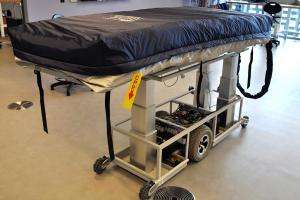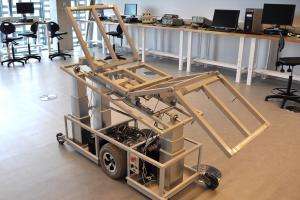Robotic hospital beds are the future of patient transportation

A new autonomous hospital bed is set to revolutionise hospital practices and patient transportation. A team from the UTS Centre for Health Technologies in collaboration with KTH Royal Institute of Technology has developed the world's first robotic hospital bed frame and mattress.
On average, a patient is moved through seven different beds of various sizes and functionality on their journey from ambulance to recovery ward. The Stockholm Institute first approached UTS citing a need to address the high level of manual handling and repetitive strain injuries (RSI) caused by heavy patients lifting to and from hospital beds.
"For hospital staff, the Flexbed reduces their RSI problems because the bed has its own driving capabilities and doesn't need to pushed or pulled. Hospital staff can just lead it to where it needs to go," said project lead, Ray Clout. "Staff also don't need to lift patients, so again, those manual handling problems can be significantly reduced."
As well as replacing all seven types of hospital beds, the Flexbed also incorporates all the multiple beds' movements, including suitable Trendelenburg (head lower than feet) and reverse Trendelenburg positions for surgery.
Complete with encoded driving wheels, Wi-Fi control, laser sensors for collision avoidance and a tracking camera, the autonomous robot follows its assigned hospital employee through crowds, right into the operating theatre. Surgeons can then tilt the bed up to 30 per cent in either direction using an app on their smart phone.
Based on evidence that suggests human error is a major risk factor in patient transportation, the Flexbed provides a safer, more efficient way of moving patients between different locations. For patients suffering from head injuries, for example, the Flexbed reduces both the time and risk involved in the critical transportation process.

"It's also got a CPR mode, meaning it lowers itself and allows hospital staff to perform CPR – and all of which is controlled by an app," Clout said. "Plus it's traumatic for patients to move from bed to bed, so if they can stay on the one bed for their entire stay at the hospital that's got to be a bonus."
The bed, rated up to 300kg and built from MRI-friendly stainless steel, is also accompanied by a specifically designed mattress, fitted with pressure sensors to address the problem of bed sores. The sensors constantly monitor the body for pressures and air oscillates to relieve the pressure the sensors find.
"The Flexbed prototype is now ready for commercialisation and we are on the lookout for a company to license it," said Professor Hung Nguyen, Director of the Centre for Health Technologies.
Current hospital beds that have basic functions like a button to raise or lower the patient typically cost $23,000. The Flexibed can be designed and built for the same price and include all the added abilities.















